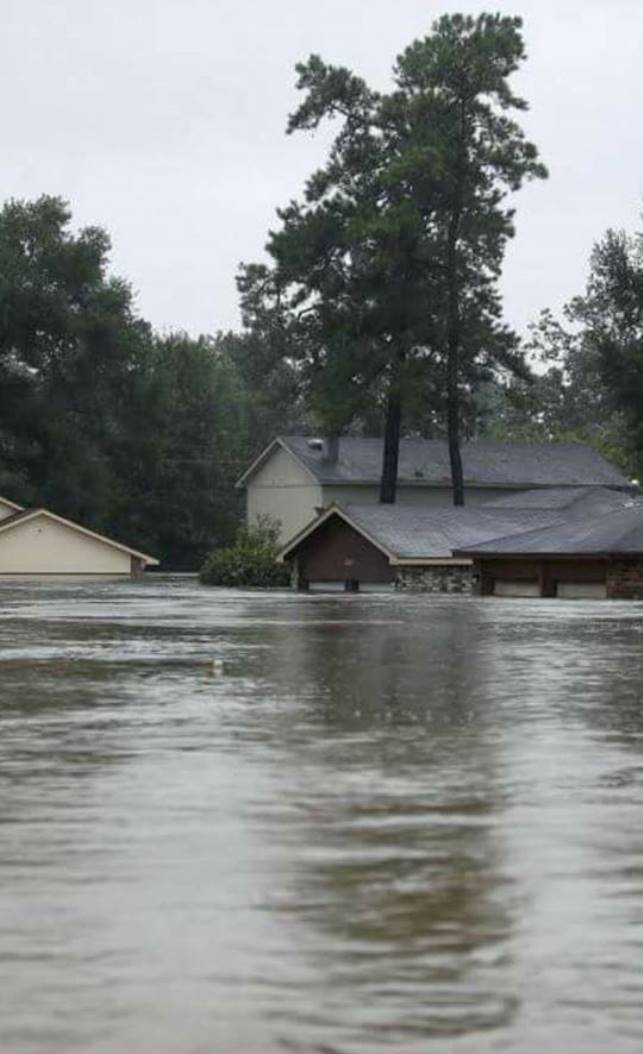
Houston flood at Sherry Smith’s home.
DETROIT CONNECTIONS: Jerry Bell, Jr.’s sister, family stranded in flood, have since been rescued
August 30, 2017

Sherry Smith

Family member

Bell family members
Please pray for my sister Sherry Smith and family members that are trapped in the Texas flood waters. I just got off the phone with her and she said that the water was pretty high up and that they were waiting for rescue. This is a photo that she sent to me. (See above.)
Update: l received a call from my sister in Texas. Both her and the kids have been rescued and taken to a safe location. Thank you for all of your prayers.

Jerry T. Bell, Jr. (r) with Kevin Kellom, father of Terrance Kellom, at vigil.
VOD: Jerry T. Bell Jr. is a well-known community activist in both Warren and Detroit. He is currently challenging Warren’s racist districting policies and election requirements. His family was devastated in 2016 when his cousin Terrance Kellom, 19, was viciously executed by a multi-agency task force in front of his father Kevin Kellom and other family members. Jerry fought for justice for Terrance Kellom. He is also an accomplished hydroplane racer who has fought for years to get into the Gold Cup races on the Detroit River, dominated by white drivers and administrators.
Can the politicians heed the lessons of Hurricane Harvey?
Posted August 30, 2017 (excerpted)https://blog.nader.org/2017/08/30/can-the-politicians-heed-the-lessons-of-hurricane-harvey/
Hovering Hurricane Harvey, loaded and reloading with trillions of gallons of water raining down on the greater Houston region—ironically the hub of the petroleum refining industry—is an unfolding, off the charts tragedy for millions of people. Many of those most affected are minorities and low-income families with no homes, health care or jobs to look forward to once the waters recede.
Will this tragedy teach us the lessons that so many politicians and impulsive voters have been denying for so long?
The first lesson is that America must come home: we must end the Empire of Militarism and of playing the role of policeman of the planet. Both of these habitual roles are backfiring and depleting trillions of taxpayer dollars that could be better used toward rebuilding our country’s infrastructure, strengthening our catastrophe-response networks and preparing for the coming megastorms like Hurricane Harvey. A projected trillion dollars being spent by Obama, and now Trump, just to upgrade nuclear weapons will only spur another arms race with Russia and China. This money could be more productively spent protecting Americans from immediate threats, such as natural disasters from man-made climate change.
Politicians must stop overstuffing a bloated military budget and leaving our country fiscally unprepared to handle mass epidemics and mass megastorms. In short, will they stop leaving our country defenseless against the prospects of huge levels of mortality and morbidity?
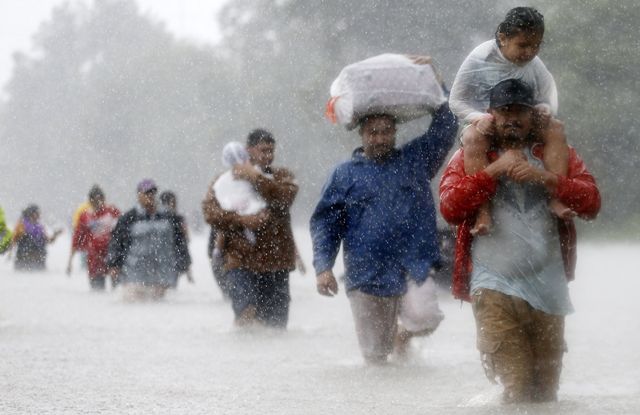
Houston residents make their way on foot through flood -where is the military now?
Second, Congressional and White House deniers of man-made climate disruption must renounce their dogmatic ignorance and confront the reality in the scientific warnings about the accelerating wrath of a provoked natural world.
Last month, I asked Oklahoma Senator James Inhofe—who has called climate change a “hoax”—what level of evidence would change his mind about climate change. He has not replied yet. But that is the question that should be asked of all Trumpsters, including the voters who share their disregard: Just what series of climate events – what piles of scientific measurements and documentations now in the Arctic, the Andes, Antarctica, Greenland, the Maldives, etc. – could change their minds?
Third, our elected officials must accept that continuing to waste trillions of dollars on corporate subsidies, bailouts, giveaways and lack of enforcement of costly crime—crony capitalism—further weakens our country’s capacity to foresee and forestall omnicidal disasters.
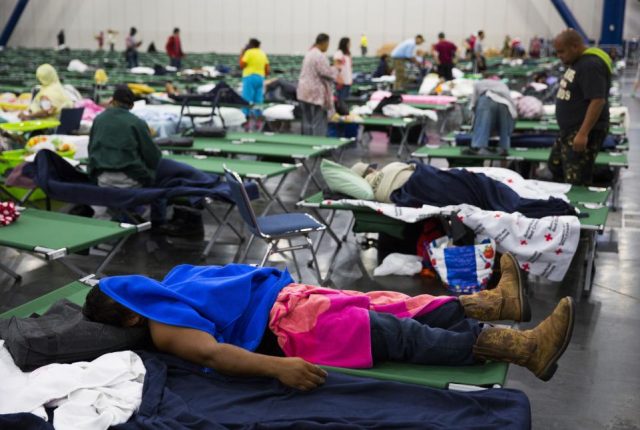
Houston residents in shelter.
Enough, also, of the Congressional Republicans starving the IRS budget so it cannot collect more of the many billions of dollars in uncollected global corporate taxes. These Republicans don’t seem to connect the size of deficits, which they detest, with uncollected tax revenue, now estimated by the IRS to exceed $350 billion a year.
Maybe someone should finally write a book entitled “Listen, Voters.” It could start by asking why enough voters keep electing politicians, who sweet talk them, only hook up with corporations and an ideology of corporatism that adversely affects the very voters who put them into office, along with many other Americans. . . .
The August 29, 2017 Washington Post paused from its extensive coverage of the destruction in Houston to laud the “Flood of Courage” in its lead editorial. It wrote of the “massive – and inspiring – volunteer rescue response…With nothing more than their own courage, good people ventured into the rushing gullies and culverts, risking their lives to save others in the unrelenting rain.”
While Trump tweets and hopefully reconsiders his earlier cruel budget cuts for FEMA and other life-saving federal agencies – such as the Centers for Disease Control and the EPA – the people are swinging into action on the ground.
Texas, Louisiana under water: Capitalist crime scene
By Deirdre Griswold posted on August 29, 2017
![]()
Aug. 29 — The coasts of Texas and Louisiana have become an ongoing crime scene. The crime is against the millions of people living along the Gulf of Mexico as well as their property — and it is a crime against nature itself.
And who are the criminals? Some are the same politicians who, like Donald Trump, jump before the cameras to assure the public that everything possible is being done to protect them, when in fact the forces of government are doing the barest minimum.

PR PHOTO FOR TRUMP, HANDING OUT BOXED LUNCHES
Others shy away from publicity — like the multibillionaire oil and gas magnates who have amassed huge fortunes over the decades promoting the very technologies that have warmed the planet and made such disasters inevitable.
They undermined mass transit in order to promote the car culture. Once the drastic effects of carbon dioxide in the atmosphere became known, what did they do? As one science publication wrote in 2015: “Exxon knew about climate change almost 40 years ago — A new investigation shows the oil company understood the science before it became a public issue and spent millions to promote disinformation.” (Scientific American, Oct. 26, 2015)
In plain words, they lied to the people. And the people are those who suffer the consequences, not the very rich who can jet to wherever pleases their luxurious lifestyle.
Texas, oil and Gov. Abbott
The human toll of this continuing tragedy will not be known until the waters subside, if ever. Unprecedented rains keep falling, turning an area the size of South Carolina into a vast, muddy lake. Yet already Texas Gov. Greg Abbott is telling the people that this “is one of the largest disasters America has ever faced” and there will be “a new normal for this entire region.”
And who is Abbott? Just two months ago, he signed a resolution sponsored by the Texas Alliance of Energy Producers that urged the federal government to reverse “some of the harmful regulations that have stunted the growth of our industry.”
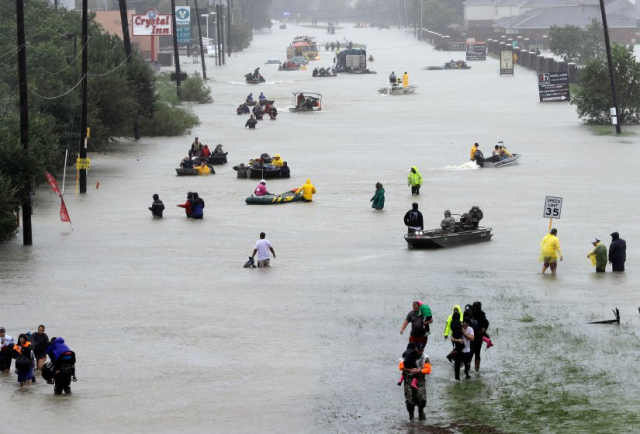
Victims of politicians’ de-regulation need to sue the oil and gas industries
The resolution applauds “the more than 20 lawsuits that Texas has filed in conjunction with many other oil and gas producing states against federal over-regulation that prioritizes minor environmental gains over major productive losses.”
“Minor environmental gains.” How ironic and telling that Hurricane Harvey, which has now dumped up to four feet of rain on parts of Texas and Louisiana since Aug. 25, is hitting the very states where the oil companies control the political structure lock, stock and barrel.
The billionaire owners of these companies should be behind bars — in the very jails that are now under water in Houston and other cities.
Scientists cannot say a particular storm is caused by global warming. There have always been hurricanes and floods. But they emphatically confirm that the increase in severe weather events now being experienced around the globe is caused by warmer temperatures.
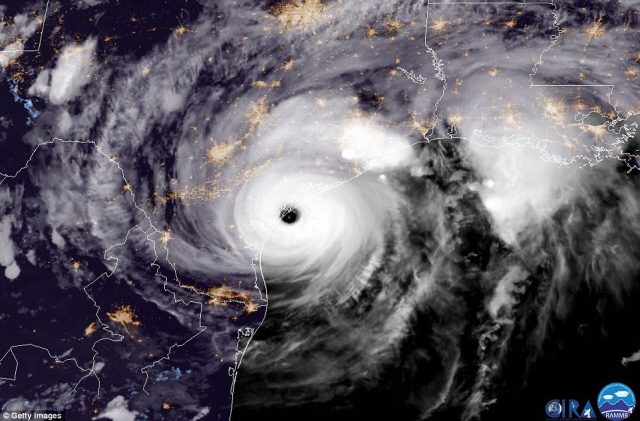
NOAA handout: satellite photo of monstrous Hurricane Harvey
Did nobody see this coming? What about this article from the Washington Post, which appeared on March 21 of this year:
“Water temperatures at the surface of the Gulf of Mexico and near South Florida are on fire. They spurred a historically warm winter from Houston to Miami. … In the Gulf, the average sea surface temperature never fell below 73 degrees over the winter for the first time on record, reported Eric Berger of Ars Technica. Galveston, Tex., has tied or broken an astonishing 33 record highs since Nov. 1, while neighboring Houston had its warmest winter on record.”
The article predicted “intense thunderstorms” would follow. Indeed they have, and much more.
A dying social system
The cataclysm of global warming is a live-or-die test of the capitalist system, which puts profits for the ruling class before everything else. And there is no question that this social system is in critical condition. The proliferation of wars and “natural” disasters around the world attests to this fact.
Moreover, the seemingly unstoppable widening of the gap between rich and poor has reached the point in the U.S. where the richest 1/100th of 1 percent now account for almost all the gains in income..
Thousands of ordinary people — not the 0.01% — have volunteered their time and boats to help the people of the Gulf Coast escape the rising waters. It is commendable, but it also shows what is lacking: an organized, massive response to a disaster situation that requires planning and the allocation of great resources. That hasn’t happened.
Is it a problem of resources? Hardly.
Beginning in 2016, the U.S. government announced it would allocate a trillion dollars — $1,000,000,000,000! — over the next 30 years to “modernizing” the U.S. nuclear arsenal. It’s one of the projects begun under President Barack Obama that Trump has had no difficulty embracing. The Alliance for Nuclear Accountability called it the “Trillion Dollar Trainwreck,” adding, “This plan directly benefits the private corporations that are invested in the maintenance and production of nuclear weapons.”
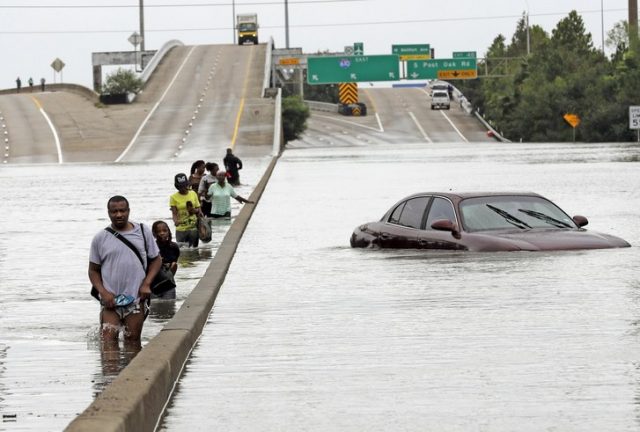
Where are the trillions Trump promised to rescue Houston residents?
What this country really needs is not more nuclear weapons in order to impose imperialist terms on the rest of the world, but an all-out plan to combat global warming. That’s already responsible for so many deaths from hurricanes, heat waves, torrential rains, flooding, mud slides — and it is only intensifying.
The answer of the Trump administration? Pull out of the Paris Accords, which were weak to begin with, and deny that climate change even exists. The country that boasts of “leading the world” is the biggest drag on human progress.
The U.S. economy has way, way overgrown this profit-motivated capitalist system. The ownership and control of the vast means of production by a handful of billionaires are completely incompatible with a globalized economy in which the labor of hundreds of millions of workers contributes to the making and distribution of every product. Capitalism is a reactionary, self-destructive anachronism that must be shattered.
Socialized ownership of the means of production is necessary if we as a species are to take control of our destiny. We have the knowledge and the means to plan for an infinitely better world. What we need is a movement independent of the corrupt political machinery that has imposed the rule of the very few on the many.
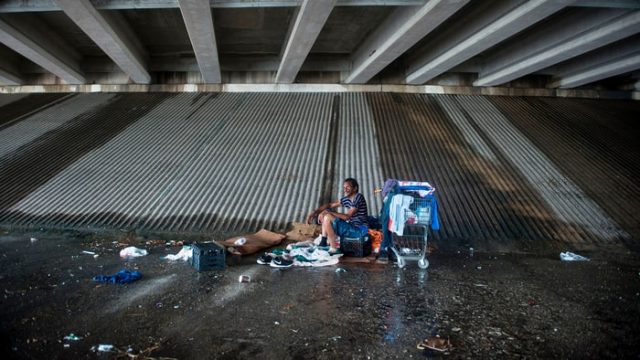
Homeless man finds shelter from the storm.
Texas toxic waste sites flooded EPA not on scene
Jason Dearen and Michael Biesecker, Associated Press Published 5:33 p.m. ET Sept. 2, 2017 | Updated 6:03 p.m. ET Sept. 2, 2017
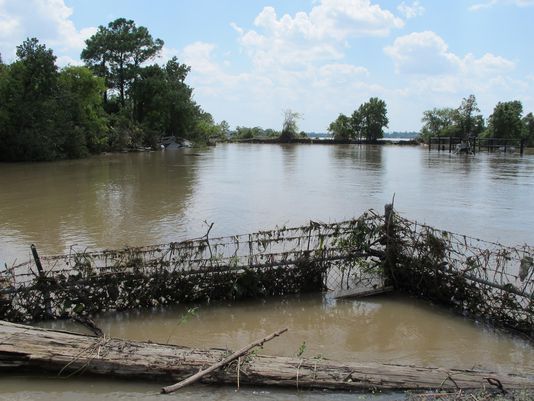
In this Aug. 31, 2017 file photo, a barbed-wire fence encircles the Highlands Acid Pit that was flooded by water from the nearby San Jacinto River as a result from Harvey in Highlands, Texas.(Photo: Jason Dearen / AP)
Highlands, Texas — As Dwight Chandler sipped beer and swept out the thick muck caked inside his devastated home, he worried whether Harvey’s floodwaters had also washed in pollution from the old acid pit just a couple blocks away.
Long a center of the nation’s petrochemical industry, the Houston metro area has more than a dozen Superfund sites, designated by the Environmental Protection Agency as being among America’s most intensely contaminated places. Many are now flooded, with the risk that waters were stirring dangerous sediment.
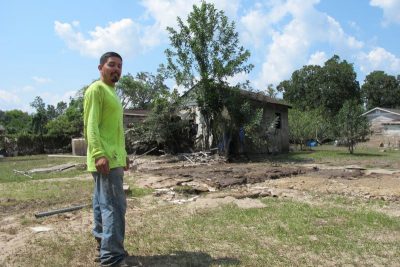
Dwight Chandler
The Highlands Acid Pit site near Chandler’s home was filled in the 1950s with toxic sludge and sulfuric acid from oil and gas operations. Though 22,000 cubic yards of hazardous waste and soil were excavated from the acid pits in the 1980s, the site is still considered a potential threat to groundwater, and the EPA maintains monitoring wells there.
When he was growing up in Highlands, Chandler, now 62, said he and his friends used to swim in the by-then abandoned pit.
“My daddy talks about having bird dogs down there to run and the acid would eat the pads off their feet,” he recounted on Thursday. “We didn’t know any better.”
The Associated Press visited seven Superfund sites in and around Houston during the flooding. All had been inundated with water; some were accessible only by boat.
EPA spokeswoman Amy Graham could not immediately provide details on when agency experts would inspect the Houston-area sites. She said Friday that EPA staff had checked on two other Superfund sites in Corpus Christi and found no significant damage.
“We will begin to assess other sites after flood waters recede in those areas,” Graham said.
At the Highlands Acid Pit on Thursday, the Keep Out sign on the barbed-wire fence encircling the 3.3-acre site barely peeked above the churning water from the nearby San Jacinto River.
A fishing bobber was caught in the chain link, and the air smelled bitter. A rusted incinerator sat just behind the fence, poking out of the murky soup.
Across the road at what appeared to be a more recently operational plant, a pair of tall white tanks had tipped over into a heap of twisted steel. It was not immediately clear what, if anything, might have been inside them when the storm hit.
EPA Administrator Scott Pruitt has called cleaning up Superfund sites a priority, even as he has taken steps to roll back or delay rules aimed at preventing air and water pollution. President Donald Trump’s proposed 2018 budget seeks to cut money for the Superfund program by 30 percent, though congressional Republicans are likely to approve a less severe reduction.
Like Trump, Pruitt has expressed skepticism about the predictions of climate scientists that warmer air and seas will produce stronger, more drenching storms.
Under the Obama administration, the EPA conducted a nationwide assessment of the increased threat to Superfund sites posed by climate change, including rising sea levels and stronger hurricanes. Of the more than 1,600 sites reviewed as part of the 2012 study, 521 were determined to be in 1-in-100 year and 1-in-500 year flood zones. Nearly 50 sites in coastal areas could also be vulnerable to rising sea levels.
The threats to human health and wildlife from rising waters that inundate Superfund sites vary widely depending on the specific contaminants and the concentrations involved. The EPA report specifically noted the risk that floodwaters might carry away and spread toxic materials over a wider area.
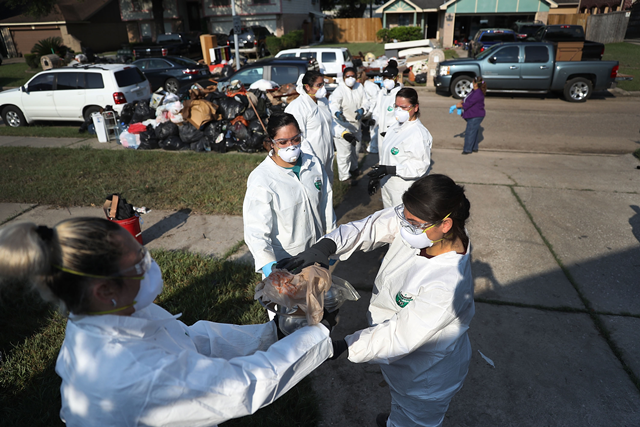
Jehovah’s Witnesses help clean out Houston home, protected against hazardous waste.
The report listed two dozen Superfund sites determined to be especially vulnerable to flooding and sea-level rise. The only one in Texas, the Bailey Waste Disposal site south of Beaumont, is on a marshy island along the Neches River. The National Weather Service said the Neches was expected to crest on Saturday at more than 21 feet above flood stage — 8 feet higher than the prior record.
In Crosby, across the San Jacinto River from Houston, a small working-class neighborhood sits between two Superfund sites, French LTD and the Sikes Disposal Pits.
The area was wrecked by Harvey’s floods. Only a single house from among the roughly dozen lining Hickory Lane was still standing.
After the water receded on Friday, a sinkhole the size of a swimming pool had opened up and swallowed two cars. The acrid smell of creosote filled the air.
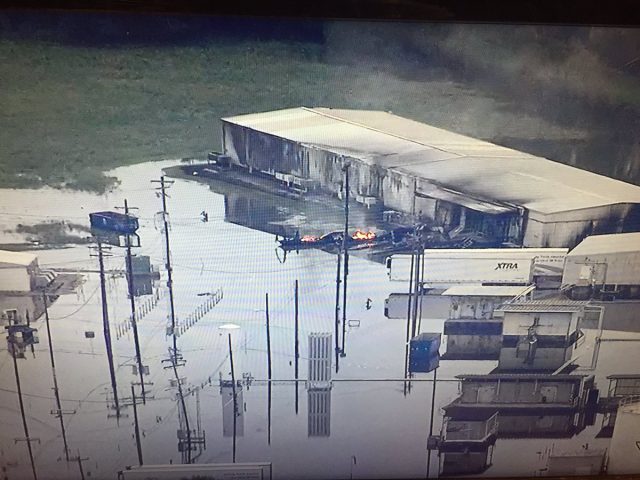
Arkema Chemical Plant in Crosby, Texas burns.
Rafael Casas’ family had owned a house there for two decades, adjacent to the French LTD site. He said he was never told about the pollution risk until it came up in an informal conversation with a police officer who grew up nearby. Most of the homes had groundwater wells, but Casas said his family had switched to bottled water.“You never know what happens with the pollution under the ground,” said Casas, 32. “It filters into the water system.”
His neighbor, Mary Ann Avila, was sobbing as she surveyed her waterlogged home across from the sinkhole. She said officials had sent her a letter warning her to have her well tested. She said her family hadn’t had any health problems in the 17 years she’s lived there.
“Even the man that drilled our well drank from it,” said Avila, 39. “But we basically just bathe, wash our face and wash our teeth with it. But not drinking water.”
The water had receded by Saturday at Brio Refining Inc. and Dixie Oil Processors, a pair of neighboring Superfund sites about 20 miles southeast of downtown Houston in Friendswood. The road was coated in a layer of silt. Mud Gully Stream, which bisects the two sites, was full and flowing with muddy water.
Both sites were capped with a liner and soil as part of EPA-supervised cleanup efforts aimed at preventing the contamination from spreading off the low-lying sites during floods. Parts of the Brio site were elevated by 8 feet.
John Danna, the manager hired by the companies to oversee the sites, said in a phone interview that he went there after the storm and saw no signs of erosion. He said he didn’t know how high the flooding got in Harvey’s wake and that no testing of the water still draining from the area had been conducted. EPA staff are expected to visit in the next week, he said.
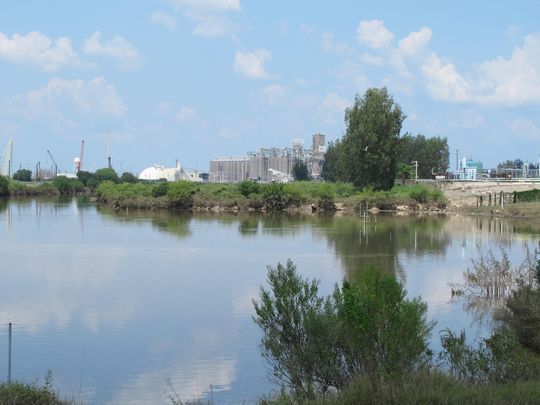
This Saturday, Sept. 2, 2017 photo shows the heavily polluted Patrick Bayou in the Houston Ship Channel that was flooded during Tropical Storm Harvey in Houston. The bayou, which sits next to a chemical plant in an intensely industrial area of Houston, is polluted with pesticides, hydrocarbons, metals and polychlorinated biphenyls (PCBs). Floodwaters have inundated at least five highly contaminated toxic waste sites near Houston, raising concerns that the pollution there might spread. (Photo: Jason Dearen / AP)
A security guard at the Patrick Bayou Superfund site, just off the Houston Ship Channel in Deer Park, said Saturday that flooding came hundreds of feet inland during the storm. The water has since receded back into the bayou, where past testing has shown the sediments contain pesticides, toxic heavy metals and PCBs. The site, surrounded by active petrochemical facilities, is still awaiting a final plan for cleanup.
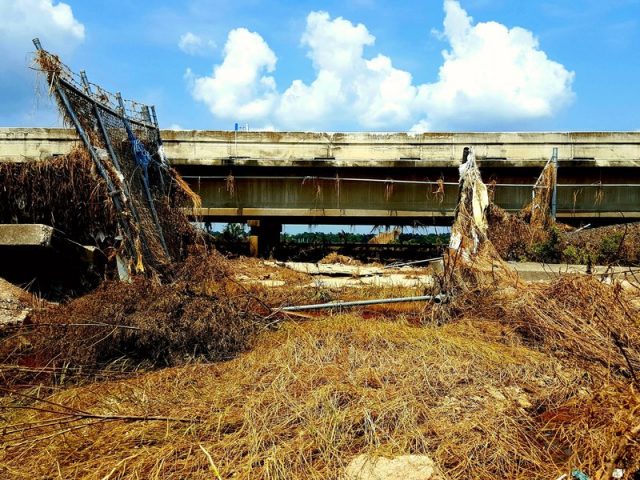
San Jacinto Superfund waste site just across the street from this scene.
The San Jacinto River Waste Pits Superfund site was completely covered with floodwaters when an AP reporter saw it Thursday. According to its website, the EPA was set to make a final decision this year about a proposed $97 million cleanup effort to remove toxic waste from a paper mill that operated there in the 1960s.
The flow from the raging river washing over the toxic site was so intense it damaged an adjacent section of the Interstate 10 bridge, which has been closed to traffic due to concerns it might collapse.
There was no way to immediately assess how much contaminated soil from the site might have been washed away. According to an EPA survey from last year, soil from the former waste pits contains dioxins and other long-lasting toxins linked to birth defects and cancer.
Kara Cook-Schultz, who studies Superfund sites for the advocacy group TexPIRG, said environmentalists have warned for years about the potential for flooding to inundate Texas Superfund sites, particularly the San Jacinto Waste Pits.
“If floodwaters have spread the chemicals in the waste pits, then dangerous chemicals like dioxin could be spread around the wider Houston area,” Cook-Schultz said. “Superfund sites are known to be the most dangerous places in the country, and they should have been properly protected against flooding.”
Houston Mayor Sylvester Turner, speaking with reporters at a news conference on Saturday after the AP report was published, said he wants the EPA “in town to address the situation.”
Turner said he didn’t know about the potential environmental concerns soon enough to discuss them with President Donald Trump.
“Now we’re turning out attention to that,” he said. “It is always a concern. The environment is very concerning, and we’ll get right on top of it.”
Associated Press writer Jay Reeves contributed to this report. Biesecker reported from Washington.




